I have a few film cameras that all mean something emotional to me (my Olympus XA2 I won in a photographic competition aged 12, my OM1 was my only camera for about 20 years until I added my Minolta Autocord, the Nikon F801 is a copy of one I took travelling around the world and I look after my Dad’s Nikon FE that he bought when I was a nipper) but I don’t use them anywhere near as much as I should, not least because I love my digital camera (Fuji XE3) with it’s perfect blend of retro feel, image quality, size and convenience.
With this in mind I have been looking for excuses to use my film cameras and all the lovely rolls of Ilford HP5 I have bought over the last year or so. Hence I have come up with a project to photograph some of the bridges over the River Thames near to where I live using a maximum of one roll for one day’s shooting.
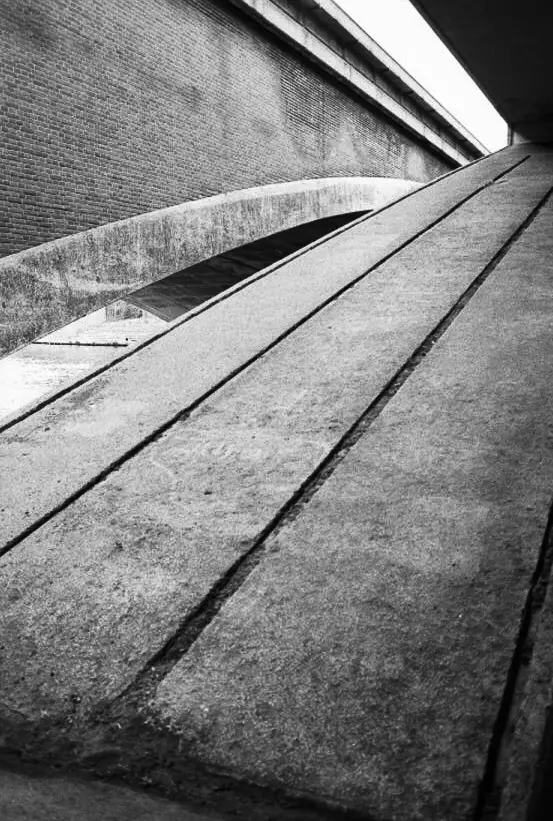
My first choice was the Runnymede Bridge that carries the M25 over the Thames just to the north of Staines upon Thames. They are actually two bridges (the other one carries the A30) but they are just a few feet apart and usually referred to as one bridge. It / they are a magnificent structure built from concrete and brick facing, started in the 1960s, expanded with the building of the M25 motorway in the 1980s and expanded yet again in 2000s when the motorway was widened so it is now the widest road bridge in the UK. It is an amazing structure that creates beautiful shapes and strong diagonals, shadows and angles and challenges the dynamic range of the film.
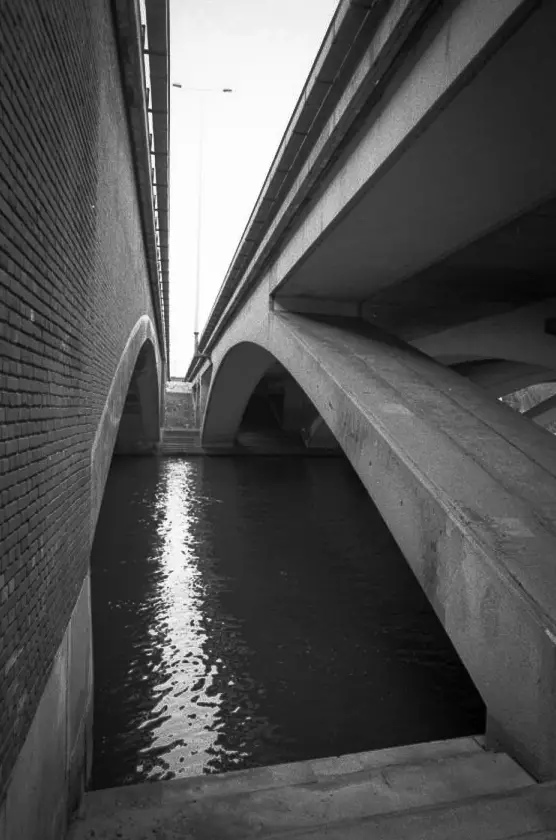
Using the OM1 again was wonderful. The three lenses I own, the 28mm f2.8, 50mm f1.8 and 135mm f2.8 are nothing overly special in themselves, but has there ever been a range of lenses so tactile and delightful to use as the small Zuikos? The camera was a delight and balanced beautifully with all three lenses, although I’m not convinced that the light meter is functioning absolutely accurately. In the dark of the shadows, the famed viewfinder of the OM1 with its huge and bright image helped composition. The HP5 seemed a perfect match for the camera and transported me back to my late teens when this was my go-to combo (unless I could only afford the cheap colour neg film from Boots).
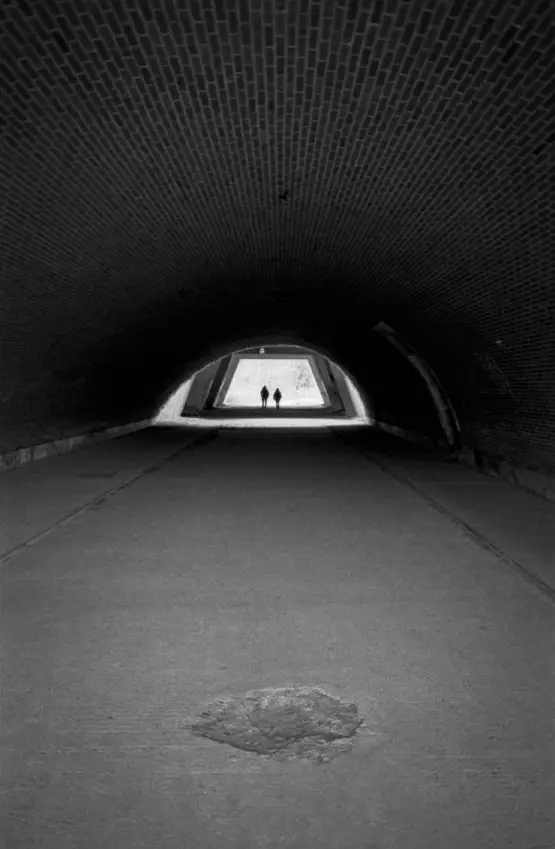
I was not quite so cheerful once I had scanned the negatives though. I develop the film myself and scan the negatives at home on my Epson flatbed scanner, so, while not exactly cutting edge, it is the only way that film photography is remotely affordable. Compared to the digital images the negs were a disappointment – lacking contrast and, worse, regularly spoiled by hair and dust. I live in a small flat with a family and three dogs so perhaps hoping for perfect images is an unattainable dream, but film negatives still need an awful lot of work, or at least in my hands, when compared to digital files.
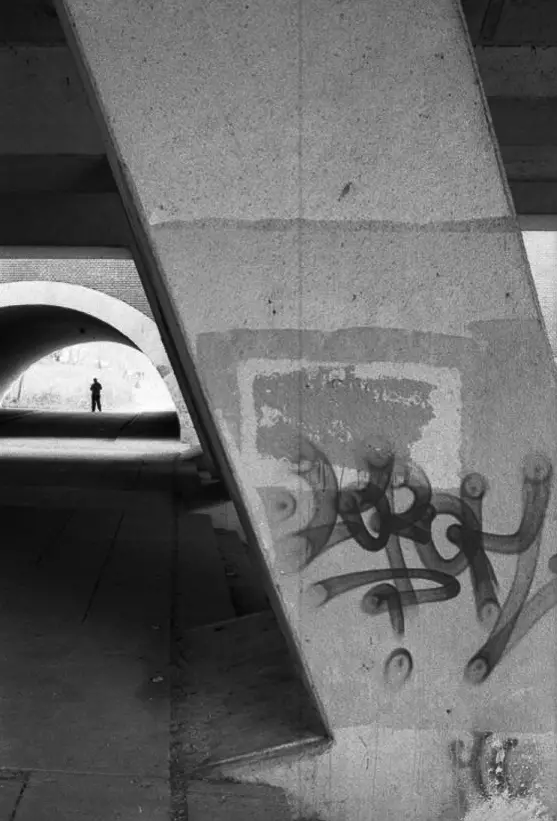
So is it worth persevering with my film based project of the bridges? It is too early to say ‘no’ and shooting the OM1 / HP5 combination was a lovely experience. I can not foresee a time when film photography reverts to being my first choice, but when the mood takes me and I feel the need to step backwards from the perfect electronic Fuji masterpiece and towards something more imperfect and personal, then I will reach for one of the cameras that mean so much to me and head out to the bridges over the River Thames.
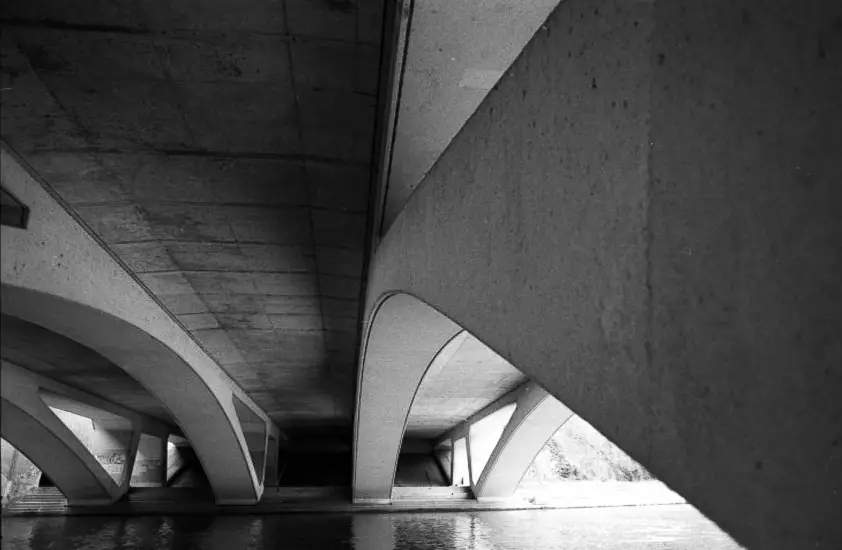
There are also some lessons from the day. Firstly, that film seems to have a narrower dynamic range than a modern day digital sensor. Second, 28mm is a wonderful focal length. Thirdly, the Zuiko lenses are fantastic and the OM1 is an amazing piece of engineering. Fourth, I need to check the light meter, or at least remember that a centre weighted meter works the photographer harder than a modern multi segment / matrix (or whatever they are called) meter. And lastly, that I should get my OM1 and probably all the other cameras, cleaned and serviced, but that pushes up the cost of film photography still further and I have a beautiful little XE3 to which I can attach the Zuiko lenses just sitting there, smiling at me……
Share this post:
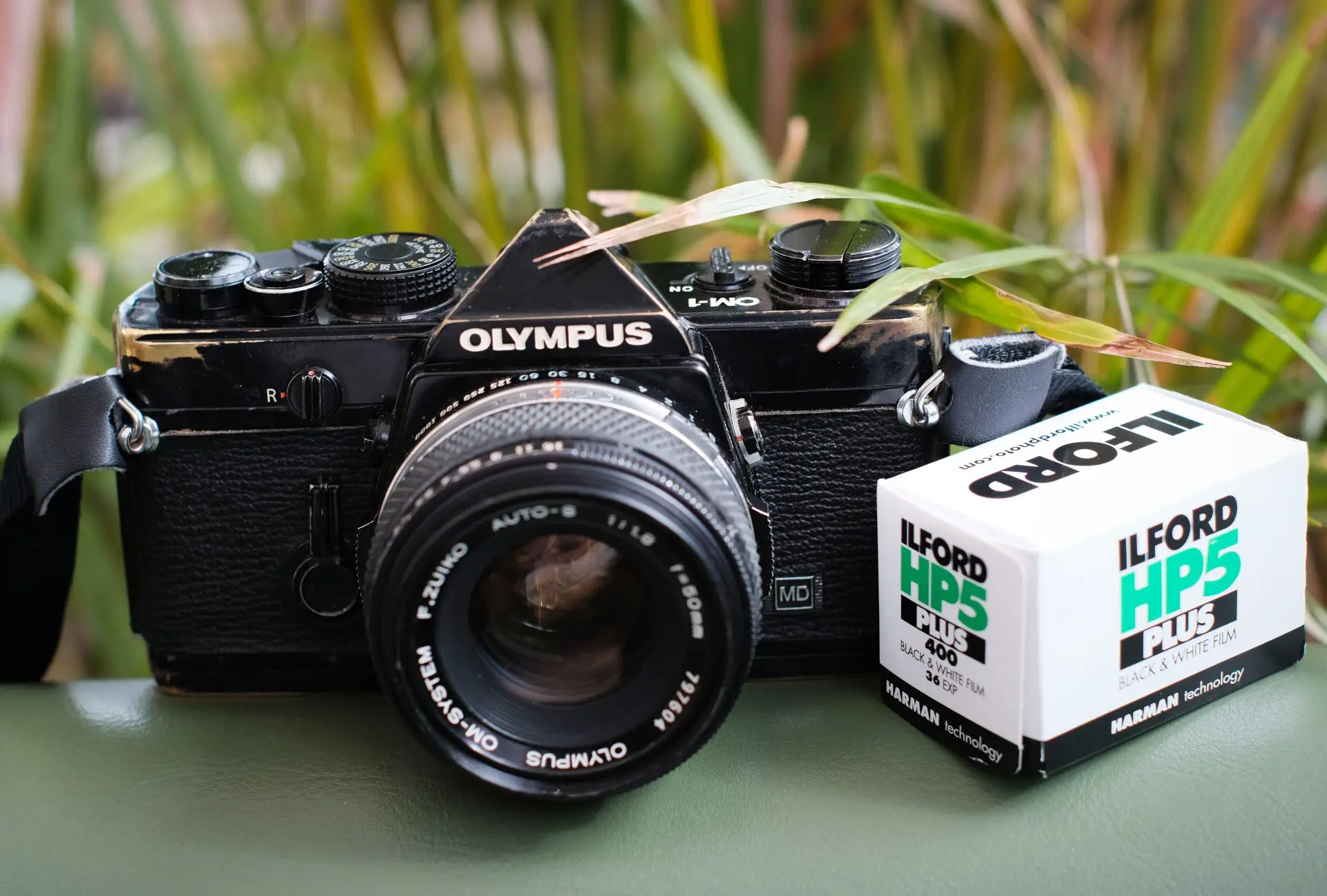








Comments
Stephen Hanka on 5 Frames with an Olympus OM1, a roll of HP5 and a Bridge
Comment posted: 20/04/2023
Comment posted: 20/04/2023
Richard Noll on 5 Frames with an Olympus OM1, a roll of HP5 and a Bridge
Comment posted: 20/04/2023
Comment posted: 20/04/2023
Eric Norris on 5 Frames with an Olympus OM1, a roll of HP5 and a Bridge
Comment posted: 20/04/2023
To see examples of my scans, check out my Instagram @campyonlyguy All of the film images there were developed and scanned by me. They may not be truly professional quality, but certainly good enough for my purposes.
Comment posted: 20/04/2023
Comment posted: 20/04/2023
Comment posted: 20/04/2023
Comment posted: 20/04/2023
Comment posted: 20/04/2023
Peter Roberts on 5 Frames with an Olympus OM1, a roll of HP5 and a Bridge
Comment posted: 20/04/2023
Personally I don't find HP5 a paricularly contrasty film, but that might just be me. If you want a bit more oomph may I suggest you try a yellow filter.
28mm is a great focal length. Funnily enough I've just read your post after getting back from a photo walk (Nunhead Cemetry). I just grabbed my bag and a roll of film to get it in before the rain started. In the bag was a 35mm and a 24mm. You've probably guessed that the 24mm was too wide and the 35mm not wide enough. Hey ho!
See you next month,
Peter
Comment posted: 20/04/2023
Julian Tanase on 5 Frames with an Olympus OM1, a roll of HP5 and a Bridge
Comment posted: 20/04/2023
The OM1 is an excellent camera, mine has 30 and still going strong, although I had to send it to CLA and whatnot twice or so. I like yours better, what with that brass showing through the black paint, gorgeous. Meter can go awry indeed, but a good repairer would put that right.
Thank you for showing these here, good luck !
Comment posted: 20/04/2023
Erik Brammer on 5 Frames with an Olympus OM1, a roll of HP5 and a Bridge
Comment posted: 20/04/2023
Please do continue with that bridges on film project. These photographs are fantastic!
I may want to check out those motorway bridges where I live in Germany. It’s a great idea for a project.
Cheers,
Erik
Comment posted: 20/04/2023
Fernando on 5 Frames with an Olympus OM1, a roll of HP5 and a Bridge
Comment posted: 20/04/2023
Comment posted: 20/04/2023
Comment posted: 20/04/2023
Comment posted: 20/04/2023
Castelli Daniel on 5 Frames with an Olympus OM1, a roll of HP5 and a Bridge
Comment posted: 20/04/2023
I would most strongly encourage you to continue the bridge project on film. You have put in place all the elements for a long term project. All the glitches you’ve mentioned are fixable. Film photography is a process of trial & error. The light meter a bit wonky on the OM-1? Pick up an inexpensive hand held meter for less than the cost of a repair. Stick to one developer. Don’t jump around. Hang your wet film in your shower. Usually a dust free space. Check for newest drivers for your scanner. Cover with a plastic sheet when not in use. Many, many on-line tutorials on scanning B&W so I’m sure you’ll find one that addresses your current results with the scans. Stick with your architectural project. Have fun. Say hello to your 4 legged friends!
Comment posted: 20/04/2023
Ibraar Hussain on 5 Frames with an Olympus OM1, a roll of HP5 and a Bridge
Comment posted: 21/04/2023
I used to have an OM2n - lovely cameras with so much quality lenses
You could’ve tried a different developer and film combination
Kodak Eastman Double-XX with say Diafine Bellini Duo would’ve given you enough room to crank up the contrast and tone as you want
Or even better if there’s enough light - Rollei Retro with Diafine would’ve given rich contrast
I’d also get myself a air blower thing - works wonders getting rid of dust and hair
Comment posted: 21/04/2023
Comment posted: 21/04/2023
Comment posted: 21/04/2023
John Salmon on 5 Frames with an Olympus OM1, a roll of HP5 and a Bridge
Comment posted: 21/04/2023
Comment posted: 21/04/2023
Comment posted: 21/04/2023
Comment posted: 21/04/2023
Bob Janes on 5 Frames with an Olympus OM1, a roll of HP5 and a Bridge
Comment posted: 21/04/2023
Makes me want to break out an OM2n...
Comment posted: 21/04/2023
Ray on 5 Frames with an Olympus OM1, a roll of HP5 and a Bridge
Comment posted: 21/04/2023
I too have a sentimental value OM-1, XA and XA2. Don’t get to use them much, but these shots are inspiring me to bring them out!
For scanning, I too struggle with my Epson flatbed. I’m thinking of creating a copy stand using my e-m1 mark iii with a macro and high res capture. It would certainly be a lot faster and I can experiment with the built in profiles.
Comment posted: 21/04/2023
Neal Wellons on 5 Frames with an Olympus OM1, a roll of HP5 and a Bridge
Comment posted: 21/04/2023
I've used Epson flatbeds for quite a few years now and have been quite happy. Sometimes I have dust and fibers but often they are minor. It is a continuing process to minimize that type of problem.
As far as contrast and the overall look goes, in the 60s through the 90s, I addressed it by selecting different contrast enlarging paper of using Polycontrast filters and paper. Now I crop and adjust levels a bit to get the same effect and it takes less than a minute for the edits.
You have great composition skills and please continue posting.
Comment posted: 21/04/2023
Kevin Pritchard on 5 Frames with an Olympus OM1, a roll of HP5 and a Bridge
Comment posted: 23/04/2023
Your graphic compositions of the bridge are excellent!
Comment posted: 23/04/2023
Dave Haynie on 5 Frames with an Olympus OM1, a roll of HP5 and a Bridge
Comment posted: 24/04/2023
Comment posted: 24/04/2023